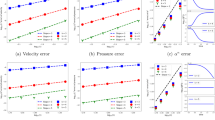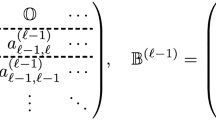Abstract
Runge-Kutta timestep schemes have been used recently in an attempt to increase the maximum stable timestep for IMPES (implicit pressure, explicit saturation) simulation of oil recovery. It has been claimed that anm-stage method will increase the real stability boundary bym 2. A rigorous stability analysis for a Buckley-Leverett problem shows that this claim is false, and that previous stabilized IMPES schemes are never more efficient than ordinary IMPES. Test calculations support these results.
Similar content being viewed by others
References
P. J. van der Houwen,Explicit Runge-Kutta formulas with increased stability boundaries, Numer. Math. 20 (1972), 149–164.
P. J. van der Houwen,Construction of Integration Formulas for Initial Value Problems, North Holland, New York (1977).
D. W. Peaceman,Fundamentals of Numerical Reservoir Simulation, Elsevier, New York (1977).
K. Aziz and A. Settari,Petroleum Reservoir Simulation, Applied Science, London (1979).
J. A. Meijerink,A New Stabilized Method for Use in IMPES-Type Numerical Reservoir Simulators, paper SPE 5247 presented at the 49th Fall Meeting of SPE, Houston (1974).
P. K. W. Vinsome,A numerical description of hot-water and steam drives by the finite-difference method, paper SPE 5248 presented at the 49th Meeting of SPE, Houston (1974).
C. A. Chase and M. R. Todd,Numerical simulation of CO 2 flood performance, paper SPE 10514 presented at the Sixth SPE Symposium on Reservoir Simulation, New Orleans (1982).
W. F. Ames,Numerical Methods for Partial Differential Equations, Nelson, London (1969).
P. D. Lax,Hyperbolic Systems of Conservation Laws and the Mathematical Theory of Shock Waves, SIAM Regional Conference Series in Applied Mathematics (1973).
B. Noble,Applied Linear Algebra, Prentice-Hall, New Jersey (1969).
R. S. Varga,Matrix Iterative Analysis, Prentice-Hall, New Jersy (1962).
C. Bolley and M. Crouzeix,Conservation de la positivité lors de la discretisation des problèmes d'évolution paraboliques, RAIRO Analyse Numérique, 12 (1978), 237–245.
M. N. Spijker,Contractivity of Runge-Kutta methods, Proceedings in Numberical Methods for Solving Stiff Initial Value Problems, G. Dahlquist and R. Jeltsch, ed., Oberwolfach (1981).
Author information
Authors and Affiliations
Rights and permissions
About this article
Cite this article
Sammon, P.H., Forsyth, P. Instability in Runge-Kutta schemes for simulation of oil recovery. BIT 24, 373–379 (1984). https://doi.org/10.1007/BF02136036
Received:
Revised:
Issue Date:
DOI: https://doi.org/10.1007/BF02136036




